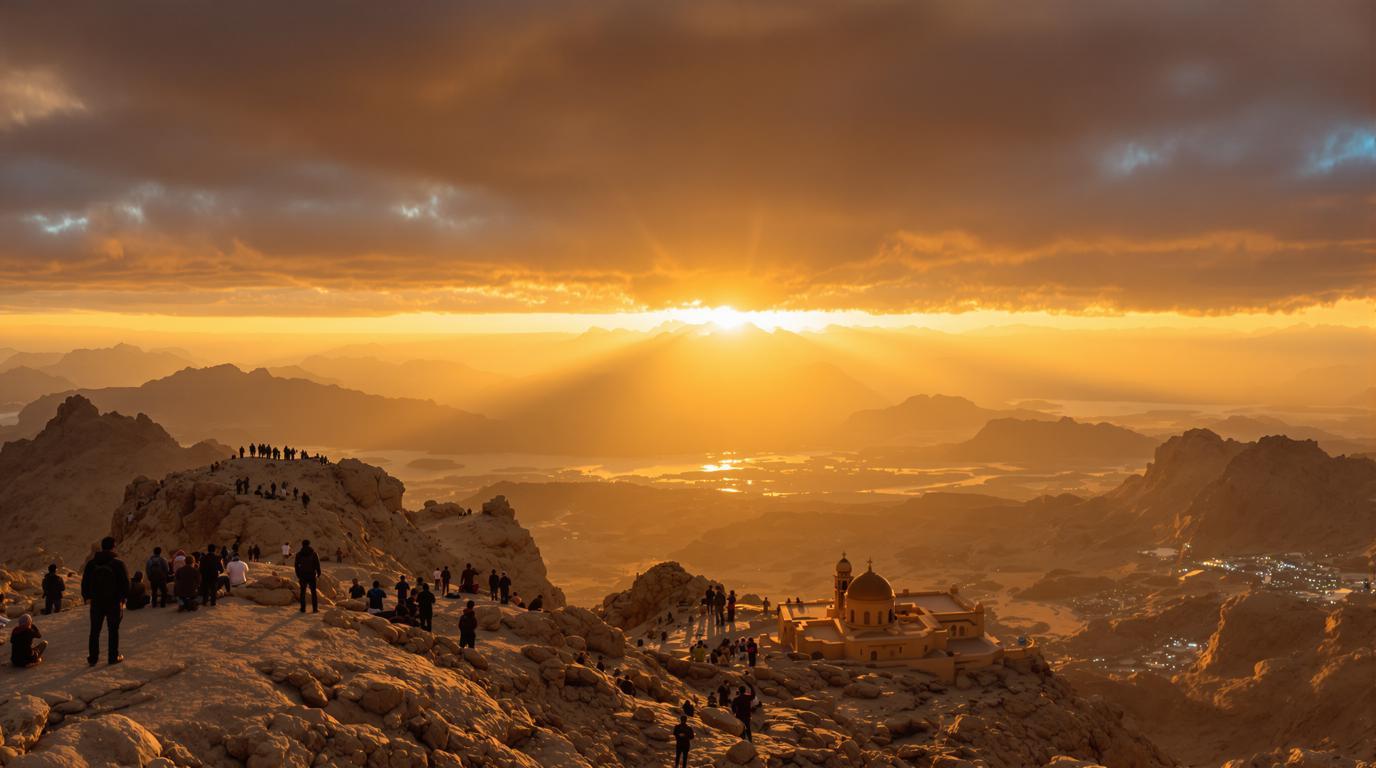Standing at the edge of Mount Sinai’s summit as the first rays of dawn pierce the horizon, I’m struck by a humbling realization: I’m witnessing the same celestial spectacle that has captivated pilgrims for millennia. This isn’t just another mountain in Egypt’s South Sinai region – it’s a sacred peak where history, faith, and natural splendor converge in a way that few places on Earth can match.
The biblical mountain where three religions intersect
Mount Sinai (locally known as Jabal Musa) holds profound significance across Judaism, Christianity, and Islam as the site where Moses received the Ten Commandments. This spiritual gravitas has made it a pilgrimage destination for centuries, drawing visitors seeking both religious connection and natural wonder.
At its base stands Saint Catherine’s Monastery, the world’s oldest continuously inhabited Christian monastery, operational since the 6th century. Its ancient walls have withstood the test of time, preserving invaluable religious artifacts and manuscripts within.
Two paths to enlightenment: choosing your ascent
Climbing Mount Sinai offers two distinct options. The gentler Camel Path winds gradually upward for about 7 kilometers, while the more challenging Steps of Repentance features over 3,750 stone steps carved by a monk seeking penitence. Both routes converge for the final breathtaking push to the 7,497-foot summit.
“The mountain has a way of stripping away pretense,” explains Ibrahim, my Bedouin guide. “Whether you arrive as a pilgrim or a tourist, everyone leaves as a seeker.”
The sunrise pilgrimage that transforms travelers
The quintessential Mount Sinai experience begins around 2:00 AM with a nocturnal ascent. Climbing by starlight and flashlight beam creates an otherworldly journey, culminating as hundreds of travelers from diverse backgrounds gather in pre-dawn silence, awaiting nature’s greatest light show.
When that first golden light breaches the horizon, illuminating a landscape of jagged peaks and vast desert, even the most skeptical visitors find themselves moved. It’s a moment that rivals Spain’s hidden medieval treasures in its ability to transport you through time.
The monastery that houses burning history
Saint Catherine’s Monastery isn’t merely ancient – it’s a living museum housing irreplaceable treasures. The Chapel of the Burning Bush marks the spot where Moses reportedly encountered the divine, while the monastery’s library contains over 3,000 manuscripts second only to the Vatican’s collection.
“We don’t just preserve history here,” notes Father Justin, a monastery resident. “We live within it, continuing traditions established fifteen centuries ago.”
Bedouin culture: the mountain’s living heritage
The indigenous Jabaliya Bedouin tribe has served as guardians of these sacred grounds for generations. Their knowledge of mountain paths, weather patterns, and ancient stories adds a cultural dimension to the journey that enhances its meaning, similar to how local wisdom enriches experiences in Cambodia’s undiscovered coastal havens.
Beyond the beaten path: hidden corners of Sinai
While most visitors focus solely on the mountain and monastery, the surrounding region offers secluded gems. Wadi el-Arbaein (Valley of the Forty) features ancient hermit caves and unexpected gardens. Nearby, the barren landscape conceals El Karm Ecolodge, where Bedouin sustainability practices showcase desert adaptation techniques.
For those seeking additional natural wonders, the colorful canyons of Colored Canyon offer landscapes as stunning as France’s hidden underground cathedrals, though formed by nature rather than human hands.
Practical considerations for the modern pilgrim
Visiting Mount Sinai requires preparation. The climate shifts dramatically from scorching days to frigid nights. Pack layers, sturdy footwear, and ample water. Most travelers base themselves in nearby towns like Dahab or Sharm el-Sheikh, joining organized tours for the 3-hour journey to the mountain.
The experience rivals the tranquility found in Sweden’s secret Mediterranean-like beaches, yet offers a completely different form of serenity – one born of historical weight rather than coastal beauty.
When to embark on your biblical journey
Avoid summer’s brutal heat (June-August) and winter’s potential snowfall. Spring (March-May) and fall (September-November) offer ideal conditions. For a truly special experience, time your visit to coincide with a full moon, when the landscape bathes in silver light reminiscent of Panama’s untouched island paradises.
Mount Sinai isn’t merely a destination; it’s a convergence point where ancient history, three world religions, and natural majesty meet. Whether you’re drawn by faith, fascination with history, or simply the promise of that transcendent sunrise, this sacred peak delivers an experience that resonates long after you’ve descended from its ancient heights.
